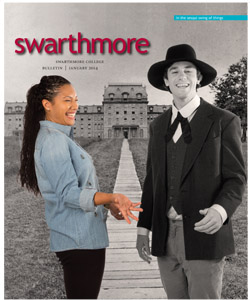Important racial-discrimination case played out on local train line
As Swarthmore College was opening its doors in the mid-1860s, so did a train on the line from Philadelphia through Westdale—to insist that an African-American woman disembark.
Teacher Mary E. Miles was traveling from Philadelphia to her home in Hinsonville, a small rural community of free black landowners near Oxford, Chester County, the location of the historically black Lincoln University. She was asked to move from her seat in the middle of a car to one “set apart for persons of her race” or leave the train. In an era when trains and streetcars were the only means of public transport, Miles refused to budge and was left at an unspecified station somewhere along the West Chester & Philadelphia Railroad (WC & PRR) line.
In early 1867, Miles brought a suit in a Philadelphia court against the railroad company, which stated in its defense that it was “not unreasonable … to seat passengers so as … to prevent contacts … arising from natural … repugnancies, which are liable to breed disturbances by promiscuous sitting.” The court countered that “defendants could not compel plaintiff to change her seat simply on account of her color.” Miles won the case and was awarded $5.
The WC & PRR then took the case to Pennsylvania’s Supreme Court. In late 1867, Justice Daniel Agnew overturned the prior ruling, stating that while he agreed that a common carrier could not refuse to take a passenger on the basis of skin color, as long as a traveler had an equally safe, comfortable and convenient seat, it was “not unreasonable to assign places … to passengers of each color.”
As an analogy, the judge offered the example of the “ladies’ car … [which] implies no loss of equal right on the part of the excluded sex …” or the separation of military from civilian passengers. In addition, the judge noted that though a March 1867 state law made it an offense for railroad companies “to make any distinction between passengers on account of race or color …” it was passed after the incident in question.
Ironically, the West Chester & Philadelphia Railroad v. Miles case, which began as a complaint against racial discrimination, later became one of many used to support the constitutionality of “separate but equal” public facilities in the landmark 1896 Supreme Court case Plessy v. Ferguson, upholding segregation for nearly 60 years until the Brown v. Board of Education ruling was issued.
Long before Rosa Parks took her famous 1955 stand against racial discrimination on a Montgomery, Ala., bus, the relatively unknown Mary Miles made a similar statement on Swarthmore’s own train line.
 Email This Page
Email This Page